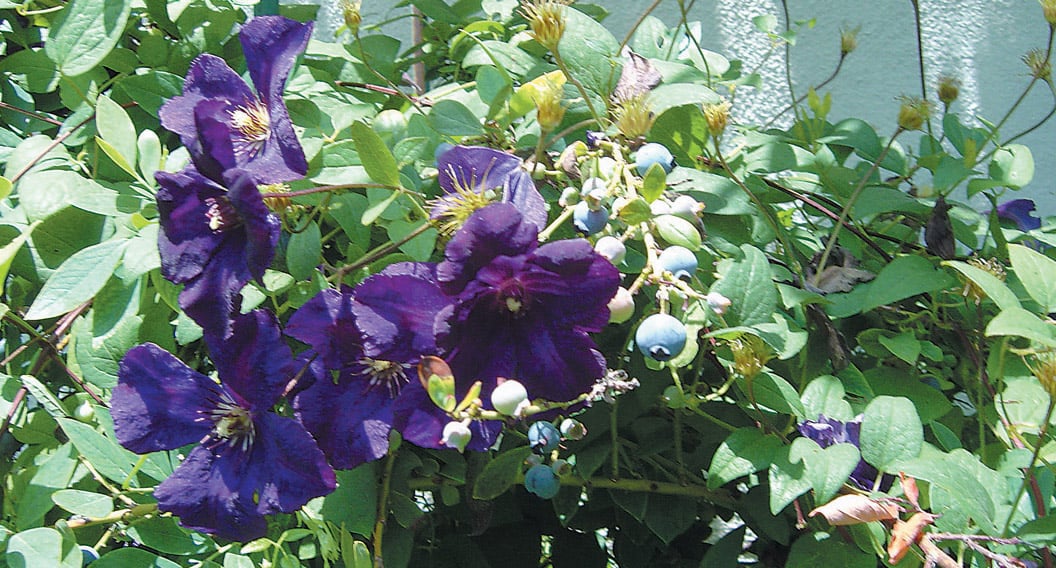

Contributor
- Topics: Archive

After much effort and expense devoted to constructing arches and trellises for a number of clematis vines, I thought I finally had all the vines trained and neatly fastened to their structures. I could just stand back and admire my tidy collection. Then, one day, I happened upon Clematis viticella ‘Polish Spirit’ refusing to grow upon its arch. Instead it had happily flopped on and meandered through a neighboring bedmate, a ‘Sunshine Blue’ blueberry. Happy companions they were, the purple flowers and blue berries complementing each other. The vine, at ease and recumbent on the shrub, needed no tying—what could be simpler?
I have been growing blueberries in my garden for about ten years now, and clematis about as long. It turns out that blueberries and clematis enjoy similar growing conditions: sun to part shade; cool, humus-rich, evenly moist soil; and acid fertilizer for the blueberries, which did not seem to be a problem for the clematis (they normally favor a more neutral soil). Since I live in mild Santa Monica, California (Sunset zone 24; USDA zone 10), I grow the low-chill southern selections of highbush blueberry (Vaccinium corymbosum); there are many to choose from.
My garden is home to about forty blueberry bushes in total, representing twelve different cultivars. All have been chosen for their low winter chill requirements, although some are experimental. Each takes up about the same volume of space as a rose bush, but they have no thorns, pests, or diseases, and look good all year. Here, they are evergreen shrubs, with white or pale pink urn-shaped blossoms in spring, and some degree of foliage color in fall and winter (depending upon the coolness of the season); loads of luscious berries appear throughout the warmer months. I do enjoy seeing other people’s roses, but nothing beats picking blueberries fresh-from-the-garden!
Our native soil is clay; the addition of homemade compost at planting time is the only soil preparation I do for the blueberries. Clay soil does have its merits; for one thing, it holds moisture better than faster draining soils. As for soil pH, some of the blueberry cultivars (‘Sunshine Blue’ and ‘Misty’) tolerate less soil acidity; most of the others prefer a pH of 4.5 to 5.5. Each winter I topdress the plants with aluminum sulfate (sold to acidify the soil, making hydrangea blossoms blue), along with more enriching compost. I water regularly, using harvested rain-water when it’s available from our 1,000-gallon homemade cistern system.
Most of the twelve cultivars I have grown produce equally well. All perform better in richer soil. The ripening season varies with the year, and is not always in agreement with the Sunset Western Garden Book or with the records of Fall Creek Nursery in Oregon (where I have purchased most of my blueberries).
Visitors often ask if the birds get the berries? They do, but the loss is negligible—perhaps only two percent of the total harvest. We have a lot of trees that provide for wildlife, both in our garden and throughout the neighborhood. I also think that interspersing the blueberries among a great variety of other garden plants makes the berries less visible—not the sort of concentration of fruit that might attract a ravenous flock. Of course, I do keep them well harvested. The blueberry bushes are of a manageable size (the largest is about six feet tall by four to five feet wide), so it would be easy to drape them with bird netting if it became necessary.
We eat fresh blueberries from March into September, but the harvest is large enough that we have a surplus to freeze, which, in turn, provides fruit for our table through fall and winter, until—believe it or not—it’s time to begin picking fresh blueberries again in the garden. What more could one want from a typical suburban lot (60 feet by 150 feet)?
For those gardening in regions with relatively mild winters (Sunset zones 8-9, 14-24), I recommend the following cultivars: ‘Sunshine Blue’, ‘Misty’, ‘Georgia Gem’, and ‘O’Neal’. It’s best to plant at least two cultivars to ensure good pollination. You’ll find the widest selection at your local nursery during the winter bare-root season. For gardeners in colder regions, there are countless other cultivars of blueberries available.
And all of these blueberries will look just fine draped with clematis, their flowers in rich shades of purple. Why not experiment with clematis in the other hues from its floral palette: lavender, violet-blue, pink, and white? You may happen upon other harmonious combinations with these recommended cultivars of handsome and prolific high bush blueberries.
Blueberries in Santa Monica
Following are the cultivars of Southern highbush blueberry (Vaccinium corymbosum) that have proven successful in the author’s Santa Monica garden (Sunset zone 24; USDA hardiness zone 10).
‘Misty’, ‘Sunshine Blue’, ‘O’Neal’, ‘Jubilee’, ‘Emerald’, ‘Jewel’, ‘Sapphire’, ‘Sharpblue’, ‘Powderblue’, ‘Georgia Gem’, ‘Cape Fear’, ‘Southmoon’.
The author was not successful with ‘Tophat’, ‘Tifblue’, or ‘Legacy’.
Share:
Social Media
Garden Futurist Podcast
Most Popular
Videos
Topics
Related Posts

Ground Up Science for Greener Cities with Garden Futurist Dr. Alessandro Ossola
Spring 2023 Listen to the Podcast here. Alessandro Ossola is a scientist who gets very excited about the challenge of climate change allowing for an

Readying Urban Forests for Climate Realities with Garden Futurist Dr. Greg McPherson
Winter 2023 Listen to the Podcast here. “Going from the mow and blow to a more horticulturally knowledgeable approach to maintaining the landscape. And that

January Showers Bring February flowers…
Fall 2022 It may not quite have the same ring to it as the old English proverb, but it has a lot more truth to

Welcome, Greywater, to the Garden
Summer 2022 Oh, summer: delightful warm air, tomatoes swelling on the vine, fragrant blooms on an evening stroll. When it’s warm and rainless, how is








Responses